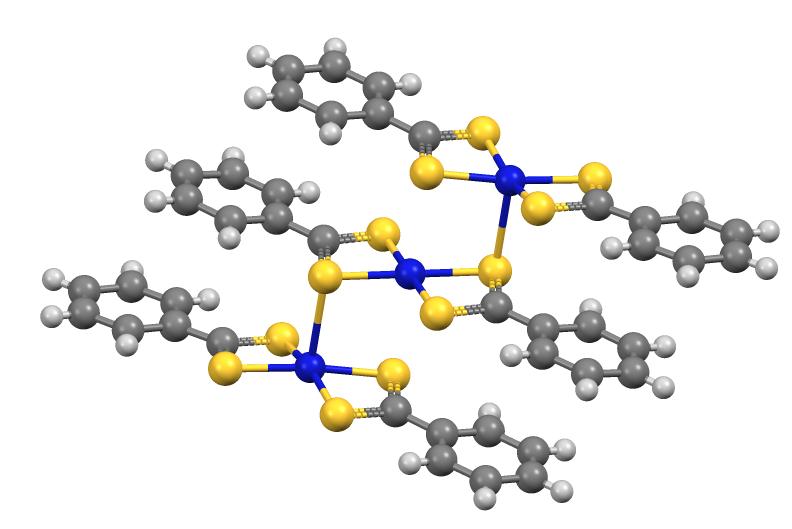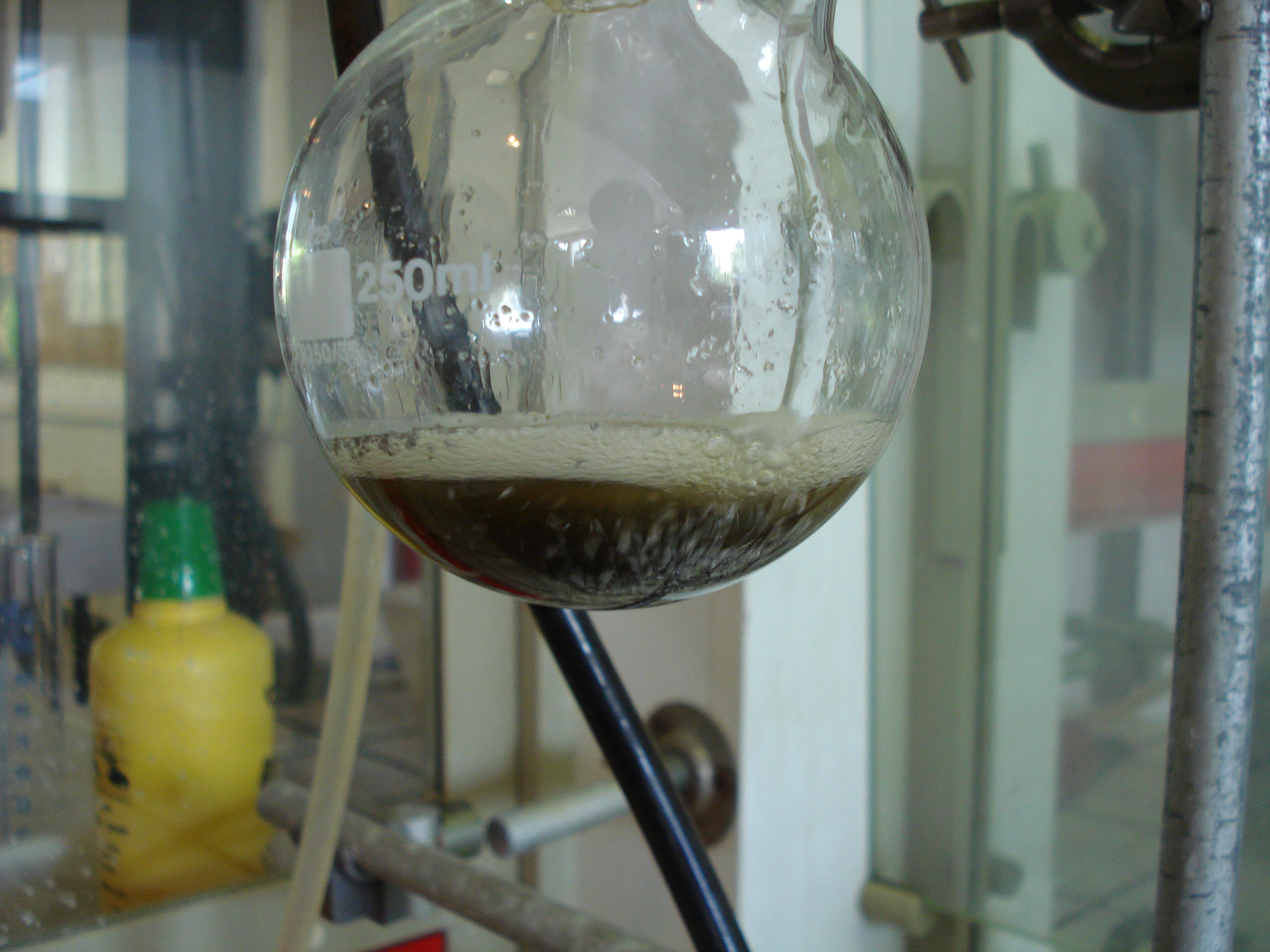|
Dithiobenzoic Acid
Dithiobenzoic acid is the organosulfur compound with the formula C6H5CS2H. It is a dithiocarboxylic acid, an analogue of benzoic acid, but more acidic and deeply colored. Synthesis and reactions It can be prepared by sulfiding benzal chloride: :C6H5CCl3 + 4 KSH → C6H5CS2K + 3 KCl + 2 H2S :C6H5CS2K + H+ → C6H5CS2H + K+ It also arises by the reaction of the Grignard reagent phenylmagnesium bromide with carbon disulfide, followed by acidification: :C6H5MgBr + CS2 → C6H5CS2MgBr :C6H5CS2MgBr + HCl → C6H5CS2H + MgBrCl It is about 100x more acidic than benzoic acid Benzoic acid is a white (or colorless) solid organic compound with the formula , whose structure consists of a benzene ring () with a carboxyl () substituent. It is the simplest aromatic carboxylic acid. The name is derived from gum benzoin, .... Its conjugate base, dithiobenzoate, undergoes S-alkylation to give dithiocarboxylate esters. Similarly, dithiobenzoate reacts with "soft" metal salts to give c ... [...More Info...] [...Related Items...] OR: [Wikipedia] [Google] [Baidu] |
Organosulfur Compound
Organosulfur compounds are organic compounds that contain sulfur. They are often associated with foul odors, but many of the sweetest compounds known are organosulfur derivatives, e.g., saccharin. Nature abounds with organosulfur compounds—sulfur is vital for life. Of the 20 common amino acids, two ( cysteine and methionine) are organosulfur compounds, and the antibiotics penicillin and sulfa drugs both contain sulfur. While sulfur-containing antibiotics save many lives, sulfur mustard is a deadly chemical warfare agent. Fossil fuels, coal, petroleum, and natural gas, which are derived from ancient organisms, necessarily contain organosulfur compounds, the removal of which is a major focus of oil refineries. Sulfur shares the chalcogen group with oxygen, selenium, and tellurium, and it is expected that organosulfur compounds have similarities with carbon–oxygen, carbon–selenium, and carbon–tellurium compounds. A classical chemical test for the detection of sulfur co ... [...More Info...] [...Related Items...] OR: [Wikipedia] [Google] [Baidu] |
Dithiocarboxylic Acid
Dithiocarboxylic acids are organosulfur compounds with the formula . They are the dithia analogues of carboxylic acids. A closely related and better studied family of compounds are the monothiocarboxylic acids, with the formula . Dithiocarboxylic acids are about 3x more acidic than the monothiocarboxylic acids. Thus, for dithiobenzoic acid pKa = 1.92. Such compounds are commonly prepared by the reaction of carbon disulfide with a Grignard reagent: : : This reaction is comparable to the formation of carboxylic acids using a Grignard reagent and carbon dioxide. Dithiocarboxylate salts readily S-alkylate to give dithiocarboxylate esters: :{{chem2, RCS2Na + R'Cl -> RCS2R' + NaCl Aryldithiocarboxylic acids, e.g., dithiobenzoic acid, chlorinate to give the thioacyl chloride In organic chemistry, thioacyl chloride is a functional group of the type RC(S)Cl, where R is an organic substituent. Thioacyl chlorides are analogous to acid chlorides, but much rarer and less robust. ... [...More Info...] [...Related Items...] OR: [Wikipedia] [Google] [Baidu] |
Benzoic Acid
Benzoic acid is a white (or colorless) solid organic compound with the formula , whose structure consists of a benzene ring () with a carboxyl () substituent. It is the simplest aromatic carboxylic acid. The name is derived from gum benzoin, which was for a long time its only source. Benzoic acid occurs naturally in many plants and serves as an intermediate in the biosynthesis of many secondary metabolites. Salts of benzoic acid are used as food preservatives. Benzoic acid is an important precursor for the industrial synthesis of many other organic substances. The salts and esters of benzoic acid are known as benzoates . History Benzoic acid was discovered in the sixteenth century. The dry distillation of gum benzoin was first described by Nostradamus (1556), and then by Alexius Pedemontanus (1560) and Blaise de Vigenère (1596). Justus von Liebig and Friedrich Wöhler determined the composition of benzoic acid. These latter also investigated how hippuric acid is related ... [...More Info...] [...Related Items...] OR: [Wikipedia] [Google] [Baidu] |
Benzal Chloride
Benzal chloride is an organic compound with the formula C6H5CHCl2. This colourless liquid is a lachrymator and is used as a building block in organic synthesis. Preparation and usage Benzal chloride is produced by the free radical chlorination of toluene, being preceded in the process by benzyl chloride (C6H5CH2Cl) and followed by benzotrichloride (C6H5CCl3): : C6H5CH3 + Cl2 → C6H5CH2Cl + HCl : C6H5CH2Cl + Cl2 → C6H5CHCl2 + HCl : C6H5CHCl2 + Cl2 → C6H5CCl3 + HCl Benzylic halides are typically strong alkylating agents, and for this reason benzal chloride is treated as a hazardous compound. Treatment of benzal chloride with sodium gives stilbene. Most benzal chloride main industrial use is as a precursor to benzaldehyde. This conversion involves hydrolysis Hydrolysis (; ) is any chemical reaction in which a molecule of water breaks one or more chemical bonds. The term is used broadly for substitution reaction, substitution, elimination reaction, elimination, and solv ... [...More Info...] [...Related Items...] OR: [Wikipedia] [Google] [Baidu] |
Phenylmagnesium Bromide
Phenylmagnesium bromide, with the simplified formula , is a magnesium-containing organometallic compound. It is commercially available as a solution in diethyl ether or tetrahydrofuran (THF). Phenylmagnesium bromide is a Grignard reagent. It is often used as a synthetic equivalent for the phenyl "Ph−" synthon. Preparation Phenylmagnesium bromide is commercially available as solutions of diethyl ether or THF. Laboratory preparation involves treating bromobenzene with magnesium metal, usually in the form of turnings. A small amount of iodine may be used to activate the magnesium to initiate the reaction. Coordinating solvents such as ether or THF, are required to solvate (complex) the magnesium(II) center. The solvent must be aprotic since alcohols and water contain an acidic proton and thus react with phenylmagnesium bromide to give benzene. Carbonyl-containing solvents, such as acetone and ethyl acetate, are also incompatible with the reagent. Structure Although phenylmagn ... [...More Info...] [...Related Items...] OR: [Wikipedia] [Google] [Baidu] |
Carbon Disulfide
Carbon disulfide (also spelled as carbon disulphide) is a neurotoxic, colorless, volatile liquid with the formula and structure . The compound is used frequently as a building block in organic chemistry as well as an industrial and chemical non-polar solvent. It has an "ether-like" odor, but commercial samples are typically contaminated with foul-smelling impurities.. It is of comparable toxicity to carbon monoxide. History In 1796, the German chemist Wilhelm August Lampadius (1772–1842) first prepared carbon disulfide by heating pyrite with moist charcoal. He called it "liquid sulfur" (''flüssig Schwefel''). The composition of carbon disulfide was finally determined in 1813 by the team of the Swedish chemist Jöns Jacob Berzelius (1779–1848) and the Swiss-British chemist Alexander Marcet (1770–1822). Their analysis was consistent with an empirical formula of CS2. Occurrence, manufacture, properties Small amounts of carbon disulfide are released by volcanic eruptio ... [...More Info...] [...Related Items...] OR: [Wikipedia] [Google] [Baidu] |
Thioacyl Chloride
In organic chemistry, thioacyl chloride is a functional group of the type RC(S)Cl, where R is an organic substituent. Thioacyl chlorides are analogous to acid chlorides, but much rarer and less robust. The best studied is thiobenzoyl chloride, a purple oil first prepared by chlorination of dithiobenzoic acid with a combination of chlorine and thionyl chloride. A more modern preparation employs phosgene as the chlorinating agent,{{cite journal, doi= 10.1002/zfch.19750150904, authors=Viola, H.;Mayer, R., journal=Z. Chem., title=Eine neue Darstellungsmethode für aromatische Thiocarbonsäurechloride, trans-title=A New Preparation Route for Aromatic Thiocarboxylic Acid Chlorides, year=1975, volume=15, issue=9, page=348 this also generates carbonyl sulfide as a by-product. PhCS2H + COCl2 → PhC(S)Cl + HCl + COS The most common thioacyl chloride is thiophosgene Thiophosgene is a red liquid with the formula . It is a molecule with trigonal planar geometry. There are two reactive C� ... [...More Info...] [...Related Items...] OR: [Wikipedia] [Google] [Baidu] |
Organic Acids
An organic acid is an organic compound with acidic properties. The most common organic acids are the carboxylic acids, whose acidity is associated with their carboxyl group –COOH. Sulfonic acids, containing the group –SO2OH, are relatively stronger acids. Alcohols, with –OH, can act as acids but they are usually very weak. The relative stability of the conjugate base of the acid determines its acidity. Other groups can lsoconfer acidity, usually weakly: the thiol group –SH, the enol group, and the phenol group. In biological systems, organic compounds containing these groups are generally referred to as organic acids. A few common examples include: * lactic acid * acetic acid * formic acid * citric acid * oxalic acid * uric acid * malic acid * tartaric acid Characteristics In general, organic acids are weak acids and do not dissociate completely in water, whereas the strong mineral acids do. Lower molecular mass organic acids such as formic and lactic ac ... [...More Info...] [...Related Items...] OR: [Wikipedia] [Google] [Baidu] |


